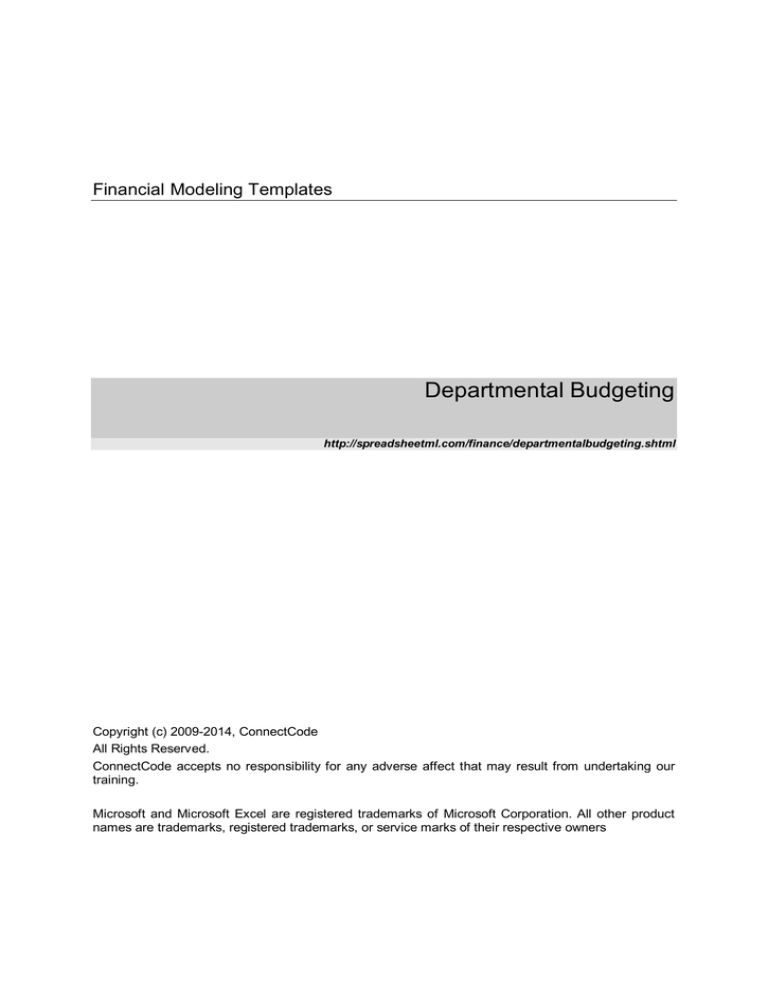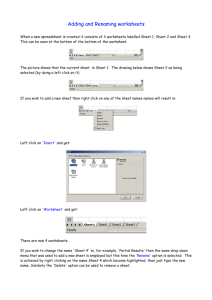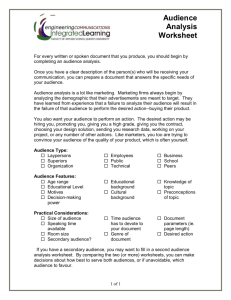
Financial Modeling Templates
Departmental Budgeting
http://spreadsheetml.com/finance/departmentalbudgeting.shtml
Copyright (c) 2009-2014, ConnectCode
All Rights Reserved.
ConnectCode accepts no responsibility for any adverse affect that may result from undertaking our
training.
Microsoft and Microsoft Excel are registered trademarks of Microsoft Corporation. All other product
names are trademarks, registered trademarks, or service marks of their respective owners
Table of Contents
1.
2.
3.
Departmental Budgeting .................................................................................................. 1-1
1.1
Overview ............................................................................................................... 1-1
1.2
Spreadsheet Overview .......................................................................................... 1-2
1.3
Worksheets outline ................................................................................................ 1-3
1.3.1 Input Worksheets ...................................................................................... 1-3
1.3.2 Output Worksheets ................................................................................... 1-3
Input Worksheets ............................................................................................................. 2-4
2.1
General Inputs ....................................................................................................... 2-4
2.1.1 General Inputs .......................................................................................... 2-4
2.1.2 Expenses Categories ................................................................................ 2-4
2.1.3 Departments/Divisions .............................................................................. 2-4
2.2
Overhead Expenses Inputs.................................................................................... 2-5
2.3
Allocate Overhead Expenses ................................................................................. 2-5
2.4
Departmental Worksheets ..................................................................................... 2-6
2.4.1 Dept Sales Inputs...................................................................................... 2-6
2.4.2 Dept Expenses Inputs ............................................................................... 2-7
Output Worksheets .......................................................................................................... 3-8
3.1
Departmental Worksheets ..................................................................................... 3-8
3.1.1 Dept Budget .............................................................................................. 3-8
3.1.2 Dept Actual ............................................................................................... 3-8
3.1.3 Dept Variance ........................................................................................... 3-9
3.2
Consolidated Worksheets .................................................................................... 3-10
3.2.1 Consolidated Budget ............................................................................... 3-10
3.2.2 Consolidated Actual ................................................................................ 3-11
3.2.3 Consolidated Variance ............................................................................ 3-11
3.3
Summary Worksheets ......................................................................................... 3-12
Pg ii
Departmental Budgeting
Version 1.0
ConnectCode’s Financial Modeling Templates
Have you thought about how many times you use or reuse your financial models? Everyday, day
after day, model after model and project after project. We definitely have. That is why we build all
our financial templates to be reusable, customizable and easy to understand. We also test our
templates with different scenarios vigorously, so that you know you can be assured of their
accuracy and quality and that you can save significant amount of time by reusing them. We have
also provided comprehensive documentation on the templates so that you do not need to guess or
figure out how we implemented the models.
All our template models are only in black and white color. We believe this is how a professional
financial template should look like and also that this is the easiest way for you to understand and
use the templates. All the input fields are marked with the ‘*’ symbol for you to identify them
easily.
Whether you are a financial analyst, investment banker or accounting personnel. Or whether you
are a student aspiring to join the finance world or an entrepreneur needing to understand finance,
we hope that you will find this package useful as we have spent our best effort and a lot of time in
developing them.
ConnectCode
Pg iii
Departmental Budgeting
Version 1.0
1.
1.1
Departmental Budgeting
Overview
A budget is simply a list of planned expenses and a forecast of the revenues of the business. It
provides a basic model of how a business will perform financially in a specific period of time. If
certain business strategies are carried out, the budget allows the business stakeholders to see the
impact on the business financially.
After a budget is created, tracking of the actual revenues and expenses are usually carried out and
the actual values are compared to the forecasted ones. This allows the company to measure the
differences or variances between the actual and the estimated values.
Discrepancies between the forecasted and actual values can be used to identify problems and
unexpected events in the business. Resolving these problems will allow the company to operate
more efficiently in the future. On the other hand, the discrepancies can be simply due to mistakes
in the estimation of the values in the budget. By identifying and reducing these mistakes, it allows
the business stakeholders to forecast and track their business results more accurately.
Pg 1-1
Departmental Budgeting
Version 1.0
1.2
Spreadsheet Overview
This spreadsheet provides a template for planning the expenses and forecasting the revenues of a
company over a 12 months period. A company may consist of several divisions or departments,
thus this spreadsheet supports the planning and forecasting of up to 5 different departments.
With input values provided by the different departments, a budget will be generated and will be
used to compare with the actual revenues and expenses subsequently. The differences between
the estimated values in the budget and the actual values can be calculated to help identify the
discrepancies quickly and easily.
The diagram above illustrates the process of using this spreadsheet. As shown in the two “square
boxes” in the above diagram, the different departments simply provide the values of the
forecasted Sales, Costs and Expenses. A departmental budget will then be automatically generated
by this spreadsheet and can be used by the department for subsequently tracking of the budget.
The different departmental budgets will subsequently be consolidated into a master budget to
provide an overall view of the company. This enables the different stakeholders of the company to
understand the business via a common platform. Overhead expenses in cost centres can also be
allocated to the different departments.
The spreadsheet assumes no accounting knowledge and guides you through the steps in
successfully creating a departmental and consolidated budget.
Pg 1-2
Departmental Budgeting
Version 1.0
1.3
Worksheets outline
1.3.1
Input Worksheets
The following table outlines the worksheets that require inputs. Different stakeholders are provided
different worksheets. For example, each of the departments will only need to enter values in the
Departmental Level worksheets.
Level
Company Level
Worksheets
General Inputs
Overhead Expenses Inputs
Allocate Overhead Expenses
Notes
A maximum of 50 expenses categories can
be defined and a maximum of 5
departments are supported.
The spreadsheet is unlocked and thus can
be customized to support more expenses
categories and departments.
Departmental Level
Dept Sales Inputs X
Dept Expenses Inputs X
A maximum of 5 departments is supported
currently. The different departments are
identified by the department numbers X.
The estimated value for the budget and the
actual values can be entered in the same
worksheet.
1.3.2
Output Worksheets
The following table outlines the worksheets that are automatically generated.
Level
Departmental Level
Worksheets
Dept Budget
Dept Actual
Dept Variance
Notes
Both a Monthly Budget and a Cumulative
Budget will be generated.
The Dept Actual worksheet is similar to the
Dept Budget worksheet except that it is
used for tracking the actual business sales
and expenses.
The Dept Variance worksheet is used for
identifying the discrepancies between the
forecasted and the actual values.
Company Level
Consolidated Budget
Consolidated Actual
Consolidated Variance
Summary Budget
Summary Actual
Summary Variance
The Consolidated Budget combines all the
values of the different departmental
budgets.
The Consolidated Actual and Variance
worksheets are use for tracking the
differences between the forecasted and the
actual values.
The summary worksheets provide a one
page overview of the budget’s forecasted
and actual values.
Pg 1-3
Departmental Budgeting
Version 1.0
2.
Input Worksheets
It is important to note that all worksheets with names ending with “Inputs”, for example,
“Overhead Expenses Inputs” requires inputs to be entered. The values in other worksheets are
automatically generated. Fields marked with “*” in the input worksheets require input values,
other fields are generated or used for interim calculations.
It is also important to note that all worksheets with names beginning with “Dept” are departmental
level worksheets.
2.1
General Inputs
2.1.1
General Inputs
Company Name* - The name of the company.
Date* - The start date for the financial plan.
The Start Year, Start Month and Start Day of the financial plan are calculated automatically from
the Date field. These three fields are used for date calculations in the subsequent worksheets.
2.1.2
Expenses Categories
This spreadsheet allows you to define up to a maximum of 50 expense categories. The expense
categories will be automatically propagated to the Departmental, Consolidated and Summary
Budgets/Actual/Variances worksheets.
The most important expense categories should be defined first as the first 5 expense categories will
be shown in details in the consolidated budget. Other expenses beyond the first 5 will be shown as a
total value in the consolidated budget.
The Expenses No. field can be modified to be the accounting codes of the company if required. This
will allow for better tracking of the expenses. This number does not affect other worksheets.
2.1.3
Departments/Divisions
The Departmental Budgeting spreadsheet supports up to 5 departments. The names of the different
departments can be defined in this worksheet. The names will be used to identify worksheets
belonging to the same department subsequently.
Pg 1-4
Departmental Budgeting
Version 1.0
2.2
Overhead Expenses Inputs
Overhead expenses refer to expenses that do not directly relate to the generation of profits in each of
the departments but are required for the continual functioning of the business. This worksheet allows
the estimated overhead expenses to be entered in the first section named “Plan”.
The next section “Actual” allows the actual overhead expenses to be entered and subsequently
tracked. The diagram below shows the “Plan” section of the worksheet.
2.3
Allocate Overhead Expenses
The overhead expenses can be allocated to different departments. This worksheet allows you to
specify the percentage point that the total overhead expenses to be allocated to the different
departments. The only field that requires input is the Budget Allocation field which is marked with “*”.
Other fields are calculated automatically to assist in the allocation of the expenses.
The “Plan” section of the worksheet shows the allocation of the budget expenses while the “Actual”
section shows the allocation of the actual expenses. The diagram above shows the “Plan” section of
the worksheet.
Pg 1-5
Departmental Budgeting
Version 1.0
2.4
Departmental Worksheets
The departmental worksheets allow the different departments to provide sales forecast and plan for
expenses in the next 12 months. The actual sales and expenses can be entered subsequently to be
compared to the estimated values.
2.4.1
Dept Sales Inputs
A business earns profits by selling goods, products or services. This worksheet is used for
forecasting sales for the next 12 months. Simply enter the values for the following fields and it will
be incorporated into the budget worksheets.
Price* - The price of the goods, products or services.
Volume* - The number of units of the goods or products sold.
Cost* - The direct cost of the goods, products or services. This is the usually cost for
manufacturing the product.
The worksheet supports a maximum of 20 products per department.
This worksheet allows the forecasted Price, Volume and Cost to be entered in the first section “Plan”.
The next section “Actual” allows the actual Price, Volume and Cost to be entered. The diagram above
shows the “Plan” section of the worksheet.
Pg 1-6
Departmental Budgeting
Version 1.0
2.4.2
Dept Expenses Inputs
Other than the direct costs associated with producing goods and services, other costs like salary,
marketing and administrative expenses will need to be calculated to determine the profitability of
the department. This worksheet allows all the selling, administrative and general costs of running
a business to be entered. The expenses will then be incorporated into the budget worksheets.
This worksheet allows the forecasted Expenses to be entered in the first section “Plan”. The next
section “Actual” allows the actual Expenses to be entered. The diagram above shows the “Plan”
section of the worksheet.
Pg 1-7
Departmental Budgeting
Version 1.0
3.
3.1
Output Worksheets
Departmental Worksheets
The Departmental Budgeting spreadsheet automatically generates the following departmental
worksheets:
Dept Budget Worksheet
Departmental Monthly Budget
Departmental Cumulative Budget
Dept Actual Worksheet
Departmental Monthly Actual
Departmental Cumulative Actual
Dept Variance Worksheet
Departmental Monthly Variance
Departmental Cumulative Variance
Details on each worksheet will be described in the sections below.
3.1.1
Dept Budget
This worksheet shows the Monthly Budget of a department for the next 12 months in the first
section. Basically, it shows Operating Income as Sales minus Cost of Sales and Expenses. The
Overhead Expenses are deducted from the Operating Income to derive the final income.
The Cumulative Budget is generated in the second section of this worksheet. The Cumulative Budget
shows the cumulative total of the monthly figures. For example, the Cumulative Sales for February is
the total of the Monthly Sales in January and Monthly Sales in February.
3.1.2
Dept Actual
This worksheet tracks the actual profitability of department over the next 12 months. The diagram
below shows the first section of the worksheet that illustrates the Monthly Actual of the
Department. The values are calculated from the “Actual” section from the Dept Sales Inputs and
Dept Expenses Inputs worksheets.
Pg 1-8
Departmental Budgeting
Version 1.0
The Cumulative Actual is shown in the second section of this worksheet. The cumulative total is
calculated by summing the monthly values in the first section of this worksheet.
3.1.3
Dept Variance
This worksheet calculates and illustrates the Variance of the profitability of department over the
next 12 months. The Variance $ is Actual minus Budget. The Variance % is calculated as the
difference (Actual minus Budget) divided by Budget. The first section shows the Monthly Variance;
the second section shows the Cumulative Variance.
Pg 1-9
Departmental Budgeting
Version 1.0
3.2
Consolidated Worksheets
The Consolidated Worksheets combine the values from the different departments to provide a
consolidated Budget, Actual and Variance for the company. The following consolidated worksheets
are generated automatically to provide a detailed view of the financial performance of the different
departments in the company:
3.2.1
Consolidated Budget
Consolidated Actual
Consolidated Variance
Consolidated Budget
The following diagram shows the Consolidated Budget. The Sales, Cost of sales and Gross Profit are
further breakdown by the different departments. This allows the different departments to be compared
easily.
The following diagram shows the breakdown of Expenses by the different departments. The first 5
Expenses are provided in a detailed breakdown by departments. The rest of the expenses are
shown as a total. This is the reason why we emphasized on defining the most important Expenses in
the General Inputs worksheet first.
Pg 1-10
Departmental Budgeting
Version 1.0
The Operating Income by departments is calculated as shown below.
3.2.2
Consolidated Actual
The Consolidated Actual is very similar in layout to the Consolidated Budget. It is a worksheet that
combines the actual revenues and expenses of the different departments. The values are
consolidated from the following worksheets.
Dept Sales Inputs 1 (“Actual” section)
Dept Expenses Inputs 1 (“Actual” section)
.
.
.
Dept Sales Inputs 5 (“Actual” section)
Dept Expenses Inputs 5 (“Actual” section)
3.2.3
Consolidated Variance
The Consolidated Variance allows the discrepancies between the Consolidated Budget and the
Consolidated Actual to be compared easily in one single worksheet. A breakdown by the different
departments is also provided as shown in the diagram below.
Pg 1-11
Departmental Budgeting
Version 1.0
The estimated and actual Sales for the different departments are shown above. Variance $ is
calculated as the difference between Actual and Budget and Variance % is calculated as the
difference between Actual and Budget divided by Budget.
3.3
Summary Worksheets
The Summary Worksheets are similar to the Consolidated Worksheets in the previous sections.
They simplify the figures of the different departments and show the figures as a total instead of a
detailed breakdown by departments. The financial performance of the company can be viewed
easily from the Summary Worksheets. The following worksheets are generated.
Summary Budget
Summary Actual
Summary Variance
Pg 1-12
Departmental Budgeting
Version 1.0


